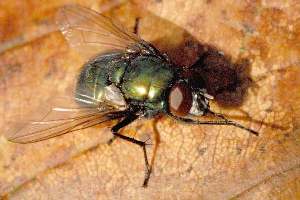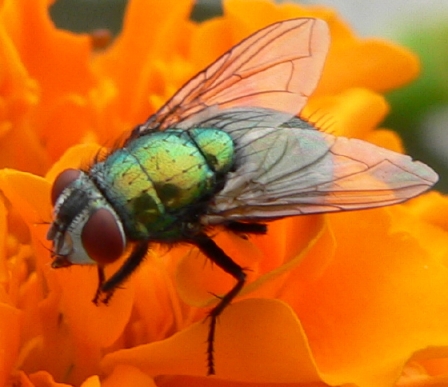Adaptation and Control
Adaptation:
The key feature to adaptation for Lucilia sericata
are their wings. The wings are attached to the mesothorax. Flies can range many miles for breeding places.
There are some factors that can influence how  far, where, and
the distance of a fly’s flight! The wind surprisingly does not
determine the dispersal of Lucilia sericata. They do
however follow the chemical cues of carrion odors and have been
found to be more active at higher light intensities. Temperature
also influences the flight of Lucilia sericata. The
distance of flight decreases between 15°C and 30°C.
It is also a possibility that barometric changes may cause
flight activity to increase right before a storm.
far, where, and
the distance of a fly’s flight! The wind surprisingly does not
determine the dispersal of Lucilia sericata. They do
however follow the chemical cues of carrion odors and have been
found to be more active at higher light intensities. Temperature
also influences the flight of Lucilia sericata. The
distance of flight decreases between 15°C and 30°C.
It is also a possibility that barometric changes may cause
flight activity to increase right before a storm.
The head of Lucilia sericata can also assist in
adaptation. The eyes and antennae are very important sensory
organs for flies. A blow fly will have a large pair of compound
eyes, one eye is on each side of the head. The antennae can help
the fly to detect wind and odor.
Flies also have a structure found on the metathoroax in place
of the hindwings called halteres. This stucture assists the fly
with balance.
Lucilia sericata will have three pairs of legs and at the
tip of each leg there will be a tiny pair of claws with pulvilli. The
pulvilli help the fly to stick to surfaces.
Control:
Lucilia sericata can be a nuisance in and around
your household. Physical control methods should be used at first
to get rid of a fly in a certain area, fly swatters are commonly
used for physical control of flies. Having good sanitation and
proper hygiene is the key to reducing the population of
Lucilia sericata in and around your household. This is
because many unsanitary places are prime places for this fly to
reproduce. There are other devices that can be used to eliminate
of Lucilia sericata that include glue boards, electric
fly zappers, and fly bottles.
fly bottles.
Flies have also been associated with food-borne diseases. The
contamination with maggots usually occurs before the time of
retail or during consumer purchase and preparation. The way that
food is prepared can kill the eggs or larvae of maggots and
decrease the risk of the consumer catching intestinal myiasis.
The most common methods of food preparation include baking,
frying, boiling, and microwaving. An example of this would be if you
were cooking raw beef,
which comes from a
cow.
At the point of purchasing the beef to cooking it there is a
possibility that eggs or larvae could have contaminated the
meat. Proper food preparation should kill all of the Lucilia sericata eggs
and larvae. This is why it is important to follow proper cooking
instructions to insure that you are eating a safe meal!
Now take a look at the nutrition page